For additional information relating to this article, please contact:
June 21, 2018EMPLOYMENT INSURANCE, APRIL 2018 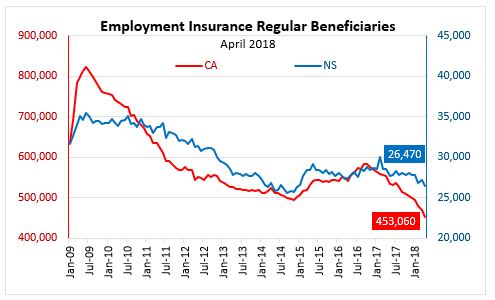
In April 2018, the number (seasonally adjusted) of Nova Scotians receiving regular Employment Insurance (EI) benefits decreased by 800 (2.9 per cent) from the previous month to 26,470 and decreased by 2,050 persons (-7.2 per cent) from April 2017.
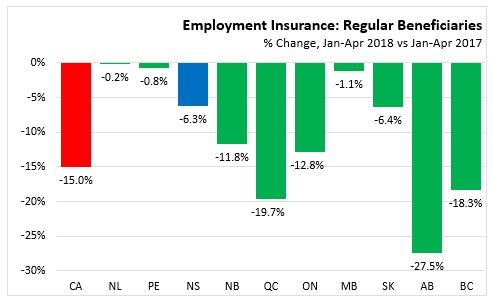
Following an increase through much of 2016, the number of EI beneficiaries in Nova Scotia declined until the middle of 2017, and remained flat through the rest of the year, and has begun to decline again in early 2018. Looking at the longer-term trends, the number of beneficiaries has been relatively stable since 2015 after reaching historic lows in 2014.
The number (seasonally adjusted) of Canadians receiving regular EI benefits in April 2018 decreased 3.4 per cent (15,940 persons) from the previous month to 453,060. The number of regular EI beneficiaries decreased by 100,200 (-18.1 per cent) from April 2017.
AGE
The bulk of EI beneficiaries in Nova Scotia are aged 25 to 54, who also account for the largest share of the labour force. In the April results, the number of beneficiaries aged 25-54 was down 370 while the number of beneficiaries aged 55 and older was down 240 persons month to month. The number of beneficiaries aged 15-24 was down 200 persons compared to the previous month.
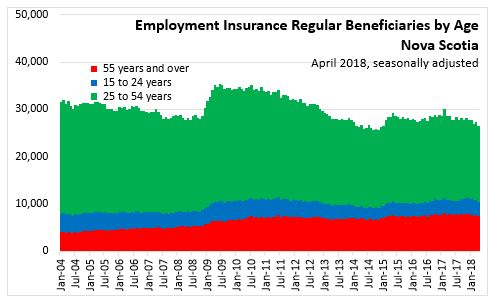
Measured as a share of the labour force, EI usage is more prevalent among older workers (6.6 per cent) than it is among youth (4.4 per cent) or core aged workers (5.2 per cent).
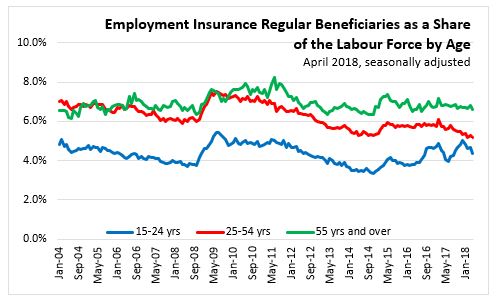
EI BENEFICIARIES AS A SHARE OF THE UNEMPLOYED BY PROVINCE
The number (seasonally adjusted) of Nova Scotians receiving regular EI benefits in April 2018 accounted for 5.4 per cent of the total labour force. In Canada, the number of EI beneficiaries accounted for 2.3 per cent of the total labour force.
In Nova Scotia, EI beneficiaries accounted for 80.7 per cent of the unemployed, compared to a Canadian rate of 39.2 per cent. Across the country, EI beneficiaries accounted for the highest shares of the unemployed in the Atlantic provinces, led by Newfoundland and Labrador. EI beneficiaries accounted for the lowest shares of the unemployed in Ontario, followed by BC and Alberta.
Note that due to differences in estimation methodology, it is possible for the reported number of EI beneficiaries to exceed the reported number of unemployed in a given jurisdiction.
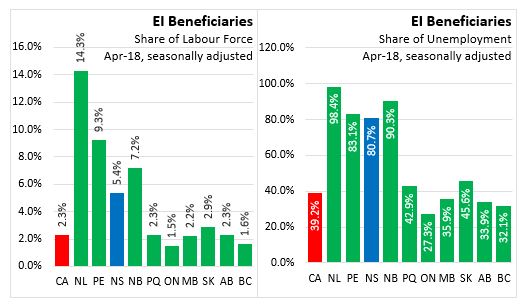
COUNTIES
In year to date terms (January-April 2018 compared to the same period a year ago), average EI usage (all types of beneficiaries, unadjusted) was up only in Cape Breton County (+0.8%). Decreases were seen in all other counties, the largest decline in percentage terms in Cumberland (-13.5%).
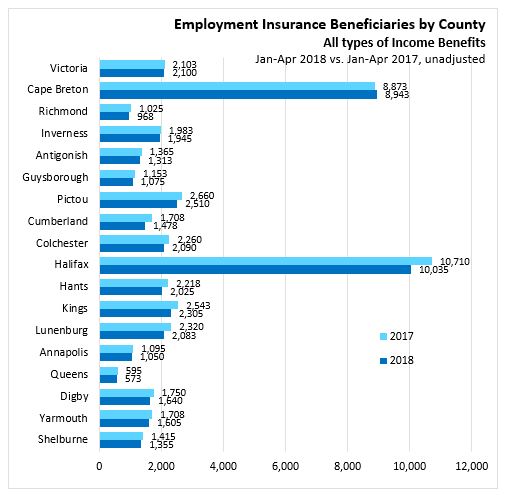
OCCUPATION
Nova Scotia's EI usage by occupation (unadjusted) is highest among trades/transport/equipment operators (8,420 this month), followed by sales and service occupations, natural resources, and manufacturing occupations.
In year to date terms, usage is up (in percentage terms) in Health occupations (up 14.6 per cent), and in unclassified occupations.
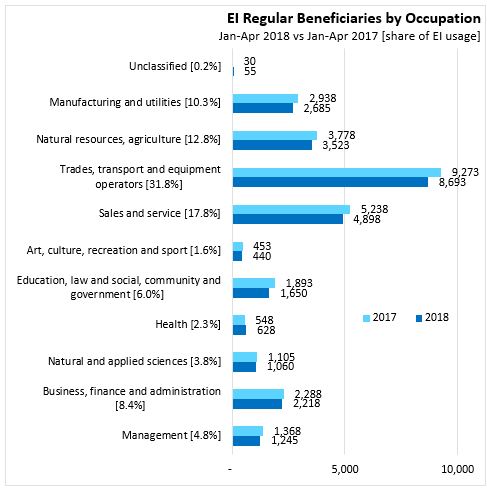
Legislative changes to the EI program came into effect in July 2016. While some of these changes affected all EI regions across Canada, eligible claimants in the 15 regions that posted notable increases in unemployment received additional weeks of regular benefits starting in July. More information on the 2016 EI changes is available on Employment and Social Development Canada's (ESDC) website. As a result of the changes to the EI program, historical comparisons are not recommended, except in areas outside of the 15 EI regions where eligible claimants received additional weeks of benefits. These 15 EI regions are Newfoundland and Labrador, Northern Ontario, Sudbury, Northern Manitoba, Southern Saskatchewan, Northern Saskatchewan, Saskatoon, Southern Alberta, Northern Alberta, Calgary, Edmonton, Southern Interior British Columbia, Northern British Columbia, Whitehorse and Nunavut.
Statistics Canada CANSIM 276-0022 (Age, Province), 276-0043 (Occupation), 276-0035 (County level)